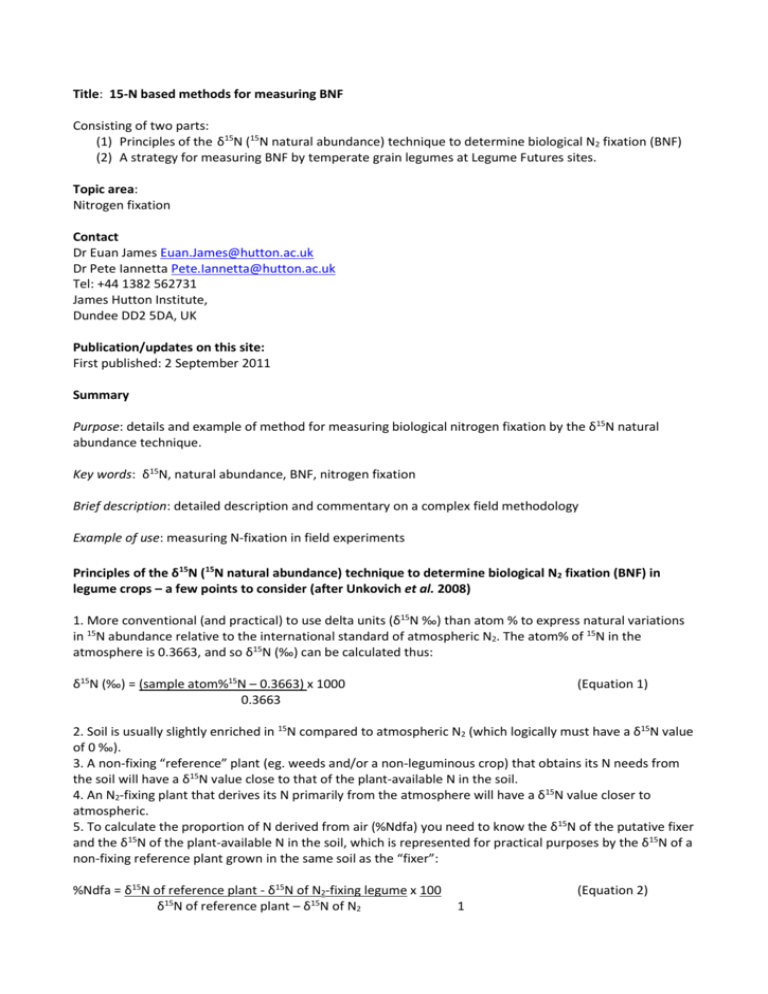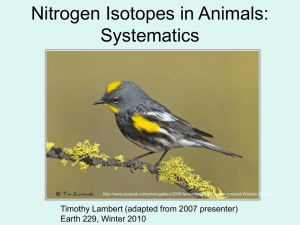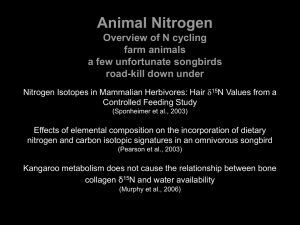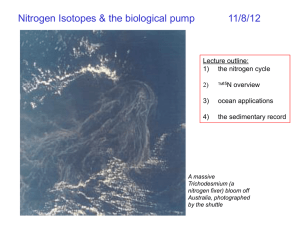Key questions to find out the best method to measure the amount of
advertisement

Title: 15-N based methods for measuring BNF Consisting of two parts: (1) Principles of the δ15N (15N natural abundance) technique to determine biological N2 fixation (BNF) (2) A strategy for measuring BNF by temperate grain legumes at Legume Futures sites. Topic area: Nitrogen fixation Contact Dr Euan James Euan.James@hutton.ac.uk Dr Pete Iannetta Pete.Iannetta@hutton.ac.uk Tel: +44 1382 562731 James Hutton Institute, Dundee DD2 5DA, UK Publication/updates on this site: First published: 2 September 2011 Summary Purpose: details and example of method for measuring biological nitrogen fixation by the δ15N natural abundance technique. Key words: δ15N, natural abundance, BNF, nitrogen fixation Brief description: detailed description and commentary on a complex field methodology Example of use: measuring N-fixation in field experiments Principles of the δ15N (15N natural abundance) technique to determine biological N2 fixation (BNF) in legume crops – a few points to consider (after Unkovich et al. 2008) 1. More conventional (and practical) to use delta units (δ15N ‰) than atom % to express natural variations in 15N abundance relative to the international standard of atmospheric N2. The atom% of 15N in the atmosphere is 0.3663, and so δ15N (‰) can be calculated thus: δ15N (‰) = (sample atom%15N – 0.3663) x 1000 0.3663 (Equation 1) 2. Soil is usually slightly enriched in 15N compared to atmospheric N2 (which logically must have a δ15N value of 0 ‰). 3. A non-fixing “reference” plant (eg. weeds and/or a non-leguminous crop) that obtains its N needs from the soil will have a δ15N value close to that of the plant-available N in the soil. 4. An N2-fixing plant that derives its N primarily from the atmosphere will have a δ15N value closer to atmospheric. 5. To calculate the proportion of N derived from air (%Ndfa) you need to know the δ15N of the putative fixer and the δ15N of the plant-available N in the soil, which is represented for practical purposes by the δ15N of a non-fixing reference plant grown in the same soil as the “fixer”: %Ndfa = δ15N of reference plant - δ15N of N2-fixing legume x 100 δ15N of reference plant – δ15N of N2 (Equation 2) 1 6. It is useful to obtain a δ15N “B-value” for the legume shoot when it is grown only on fixed N. This B-value (which will typically be in the range 0 to -3 ‰) can then be used to calculate more accurate %Ndfa values when only shoot samples are taken for analysis (which is likely), as it takes into account the isotopic fractionation that occurs within the plant for the particular legume-rhizobial symbiosis that is being measured. %Ndfa = δ15N of reference plant - δ15N of N2-fixing legume x 100 δ15N of reference plant – B (Equation 3) 1 7. The higher the reference δ15N, the more precise the estimate of %Ndfa. The δ15N of a reference plant should thus ideally be >4‰, but even better if it is >6‰. 8. Please note that non-fixing reference plants should exploit the same N-pool, and have a similar duration of growth and pattern of N-uptake as the legume. Much thought should, therefore, be taken into selecting appropriate reference plants. 9. Take care that the δ15N of the putatively N2-fixing legume falls between the “B-value” and the δ15N of the reference plant, as Equation 3 will give %Ndfa values <0% or >100%. Although there are ways to overcome this problem, if this is the case you might consider abandoning the use of the δ15N method and consider using the 15N isotope dilution method instead. 10. Do not use the δ15N method when soil N-content is very high (eg. because of previous N-fertiliser applications), as this will inhibit both nodulation and BNF by the legume. When should you consider using the 15N isotope dilution method, and how does it work? The 15N isotope dilution method has fallen somewhat into disuse since the ‘90s. This is because of great improvements in the practicality and accuracy of the δ15N technique made possible by the development of high precision mass spectrometers with a precision of δ15N ± 0.3‰ and ± 0.0001 atom% 15N. However, if you do not have access to such equipment, or if the δ15N of plant-available N in your experimental fields is <2‰, then you might consider artificially enriching the soil with 15N-labelled fertilisers. 1. In this technique: %Ndfa = atom% 15N excess N2-fixing plant x 100 atom% 15N excess reference plant (Equation 4) 2. The principle of the method is essentially the same as for the δ15N technique, except that the soil is artificially greatly enriched in 15N above background 15N abundance. 3. The main assumption underlying the technique is that the 15N enrichment of the non N2-fixing reference plant accurately reflects the 15N enrichment of soil N taken up by the legume. For this to be valid, the 15N enrichment of the soil N needs to be relatively constant over time, space and depth, or the time course and depth of soil N uptake by the reference and N2-fixing plants the same. However: The successful application of the technique depends on fulfilling point (3), but obtaining a spatially and temporally stable 15N-enriched soil is neither easy nor quick. Theoretically, it should simply be a matter of incorporating an appropriately labelled fertiliser (at a 15N level of approx. 4 atom% excess) into the soil via thorough mixing down to at least the maximum rooting depths of the legume and the non-fixing reference plants, but owing to the various physical and chemical processes that will act upon the added 15N, mixing alone will not be enough to ensure stability of the 15N signal with respect to time and depth. Time will be required, and it may take a whole season for the 15N signal to stabilise sufficiently before the labelled soil can be used with any confidence. It is for this reason, and because of the additional expense of buying the 15 N-labelled fertiliser, that I strongly advocate that the feasibility of using the δ15N (natural abundance) technique be investigated in the first instance. Unkovich M, Herridge D, Peoples M, Cadisch G, Boddey R, Giller K, Alves B, Chalk P. 2008. Measuring plant-associated nitrogen fixation in agricultural systems. Canberra, Australia: ACIAR. http:// www.aciar.gov.au/publication/MN136 A strategy for measuring BNF by temperate grain legumes at Legume Futures sites (eg. Balruddery, Dundee, Scotland) using the δ15N (15N natural abundance) technique 1. Assess the N-content of the soil in the prospective experimental sites to ensure that it is not so high that legumes, such as field bean (Vicia faba) and peas (Pisum sativum), will be inhibited from nodulating and fixing N2. 2. Assess the δ15N signal of the plant-available N in the soil by sampling non-nodulated weeds growing within the prospective sites, and then select the site(s) with the highest δ15N value to conduct the experiment. (You may have no choice in terms of sites, but these baseline δ15N values will still be valuable nonetheless). 3. Plot size will depend upon the objective of the experiment and the number of harvests planned during the experiment. If the objective is simply to estimate %Ndfa then plots do not have to be too large, but if estimates of kg N fixed ha-1 are required then determinations of plant biomass will be also be needed and plot sizes will consequently be larger. Edge effects also have to be taken into account regardless of the experimental objective. 4. Before starting the field experiment grow V. faba and P. sativum plants in sterile sand/perlite-filled pots in the greenhouse (use the same varieties that will be used in the field experiments), and inoculate them with an effective strain of Rhizobium leguminosarum bv. vicieae (“Rlv”)*. Harvest the shoots of the plants at 2 or 3 growth stages from early vegetative stage up to and including the end of pod fill, and evaluate the δ15N signature and total N content at each harvest. This should allow for the calculation of a “B-value” for each growth stage, and these B-values can then be used to calculate the %Ndfa of the field-grown plants at the same growth stages. 5. NB: Once B-values from (3) and soil/non-legume δ15N values from (2) are obtained it should then be possible to assess the feasibility of using the technique in the field eg. it may not be feasible if the soil/non-legume δ15N signature is very low (<2‰) and/or the B-value(s) are too high (see Equation 3). 6. Sow the field bean and/or pea seeds together with the non-fixing references in an appropriately randomised manner, but which also reduces errors in estimating N2 fixation due to soil heterogeneity (see Unkovich et al. 2008 for examples of plot layouts). 7. NB: When choosing reference plants to sow alongside the legume remember that there should be more than one species of references, and they should have a similar duration of growth and pattern of N-uptake as the legume. A brassica (eg. oilseed rape) and barley would be appropriate for a temperate arable system like Balruddery. Dicot weeds of a similar age to the legume can also be harvested as additional references during the duration of the experiment. 8. Do not add N-containing fertiliser to either the legumes or to the references, as they must exploit the same soil N pool for the technique to be valid. 9. At each harvest randomly select 10 sites (0.5 - 1 m2) per plot, and harvest whole shoots from 5 legumes per site. Bulk the 5 shoots for each site and dry them for at least 48 h at 65 – 80°C as soon as possible after harvest. Do likewise for the non-fixing reference plants in the same plots. 10. After weighing them, grind the samples for analysis of their N concentration and atom% 15N values. 11. The %Ndfa can be estimated using Equation 3, and the actual amount of fixed N in the shoots can then be calculated (using the total N values for the bulked shoots). 12. The amount of N fixed in plant (g N fixed plant-1) or field terms (kg N fixed ha-1) can also be estimated using the %Ndfa values, but only if the total biomass (roots & aerial parts) of the legumes is also known. *It might be better to use Rlv strains isolated from nodules on plants already growing in the experimental field, as these may be better adapted to the prevailing soil conditions. These could be applied as a soil suspension. END







